A.R. Baumann's Blog, page 2
July 6, 2016
Six Things Writing a Mystery Novel Has Taught Me
I believe a good mystery novel should make readers use their brains. And as a writer, I know it’s my job to lay out the clues, so that my readers can logically put all the puzzle pieces together and work out the whodunit. My brain was bursting at the seams with all the knowledge I’d gathered during my months of research for Under a Cloud of Rain, so I wanted to share some of the most important lessons I learned while writing a mystery novel.

1. Get out of your own head. The most important lesson I learned throughout the writing process was to follow my gut instincts and trust myself while building the bones of the book structure. Everything can get a little cattywampus once you throw all your haphazard ideas onto paper, and you realize that endlessly moving bits and pieces around is not helping but actually hindering the writing process. I don’t always know the right order for where to place the scenes I write, so I struggled with getting out of my head during editing. There were many times when I had to step back and let the book go where it took me without overanalyzing it.
2. Learn something new each day. Although the research phase for Under a Cloud of Rain was daunting and sometimes overwhelming, it opened my eyes to a lot of things. I learned more than I ever imagined I would. From my own historical investigations and visits to potential scene-building locations to one-on-one interviews with police officers, I’ve gained a much deeper appreciation for knowledge. I learned to treasure even the smallest tidbit of information, and now I try to learn something knew each day or look at some facet of life in a new way. I never know how it might help me build a scene or develop a character in the future.

3. Timing is everything. It was easy (comparatively speaking) to identify the whodunit part of my novel, but determining when to make the big reveal was more difficult. I had to painstakingly remember what happened when and where and how, what I had changed, and which characters had done what up to a certain point so as to ensure that I wasn’t giving even minor spoilers about the plot twist. I didn’t want all my hard work of building a thoughtful, suspenseful page-turner to be diminished by a clue accidentally dropped smack in the middle of the first chapter. I owe a big thank-you to my editor for her help and firm guidance on this.
4. Character is king. This one might seem obvious to any reader who has fallen in love (or hate) with a formidable protagonist, but I learned to gently massage my thoughts so that captivating characters who tell the story emerge. Dialogue and character development are two of my strengths as a writer, so creating characters was my favorite part about writing my first novel. Writing and rewriting scenes helped me mold my characters, which in turn helped build the plot.
5. Meeting deadlines is crucial. Yes, sometimes these deadlines were more self-imposed, but I respected them nonetheless. I had to focus on meeting short- and long-term deadlines during the writing process, which helped me become a better writer. I never wanted to miss a deadline and let down my publisher, my future readers, or myself.

6. Take time to paint the town and the front porch. During the launch of Under a Cloud of Rain, while I was doing interviews and scheduling book signings, I welcomed the celebration of me and my hard work. It can be difficult to be a little selfish and focus on myself sometimes, so it was important for me to let others tell me and show me that I accomplished something great. And I hope my readers feel the same!
Reader Roundup: What have you learned as a reader or a writer?
June 29, 2016
Five Facts About Vintage Chain Saws
One of the most important facets of writing a mystery murder novel is getting the details about the killer—and his or her preferred murder weapon—just right. Spoiler Alert! In Under a Cloud of Rain, my serial killer uses a chain saw. I chose the chain saw because I wanted something frightening, loud, and grotesque so that the way in which my serial killer mutilates the victims would mirror how ugly the high society culture can be.

In the course of my research, I had some interesting conversations with experts and found some great historical chain saw morsels while I was digging into the details of my killer character’s weapon of choice. Here’s a look at some of the facts I learned about vintage chain saws:
1. The origin of the first chain saw is debated, but the first “chainsaw-like” tool showed up around 1830 in Germany. The first “real” chain saw didn’t appear until one hundred years later in 1926, when German engineer Andreas Stihl invented the first electric chain saw. It was designed for handheld logging and woodcutting. You might recognize the name Stihl because the company remains one of the world’s leading (and oldest) chain saw manufacturers.
2. Chain saws are dangerous! Yes, you’re probably thinking, that’s obvious. But according to the US Consumer Products Safety Commission, the average chain saw injury requires 110 stitches. Yikes! Popular Mechanics has even rated the chain saw as one of the top five most dangerous tools. A kickback—the most common cause of chain saw injuries—happens when the chain saw unexpectedly flies back into the operator’s face. There are a slew of obvious reasons why it’s one of the most dangerous tools, but the two main causes of injury are lack of education and training and chain saw operators working too quickly and not paying attention. Fortunately, there have been major advancements in chain saw safety: Between 1970 and 1990 the number of chain saw-related accidents was reduced by almost half as a result of improved safety regulations and enhanced ergonomics.
3. The original two-man chain saws had a handle on each side with the saw in the middle. Today’s modern top-hold chain saws are much safer than the vintage versions. Manufacturers put both handles on top of the chain saw so an operator (or serial killer in my case) can position both of their hands over that center of the tool, providing more ergonomic handling when the operator must hold and work with the saw away from the body.
4. After World War II, the first gas-powered one-man chain saw was manufactured, and it weighed a whopping thirty pounds! Imagine lugging that around the forest to cut down trees. Today’s chain saws are much lighter, weighing anywhere from about six to twenty pounds. There was actually a shortage of lumberjacks in the 1950s, so people thought younger workers would be enticed to join the forestry workforce with the option of easy-to-use and easy-to-carry chain saws.
5. Another interesting fact I learned while researching chain saws for Under a Cloud of Rain is that the American horror blockbuster film The Texas Chain Saw Massacre was falsely marketed as a “true story” to attract a wider range of moviegoers. There was no “true” story involving chain saws, massacres, or even Texas!
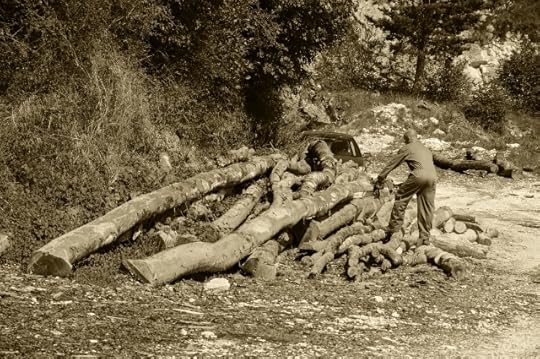
Remember: the killer never experiences a fatal chain saw kickback! I wanted the chain saw used by my serial killer in Under a Cloud of Rain to represent the ugliness of some of my affluent characters, but I mix things up in my next novel. Stay tuned in the next Nick Noelle series thriller, Thicker Than Blood, to see what the next murder weapon will be!
June 22, 2016
What Was Police Work Like in 1970s Houston?
TV dramas from the 1970s such as Starsky & Hutch and Charlie’s Angels glamorize police work and portray officers as superhuman crime fighters, but the boots-on-the-ground detectives from that era have a much more authentic story to tell—one with a lot more grit and fewer babes. Some of my most interesting research for Under a Cloud of Rain included visiting the Houston Police Department (HPD) museum, which is located in the lobby of HPD headquarters.
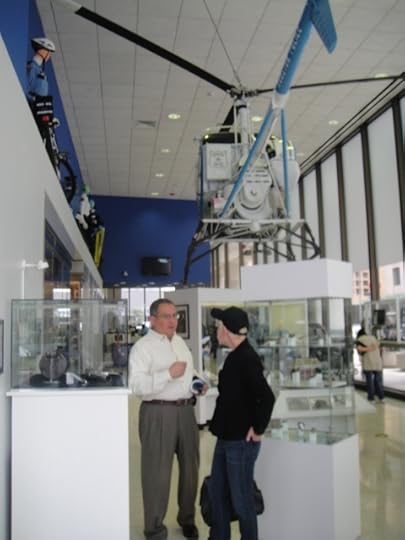
I learned so much in my interviews with some of the older, now-retired detectives who worked on the Houston police force back in the 1970s, and I wanted to shed some light on how those one-on-ones helped me build the world of my debut novel.
The first big difference between then and now is the nomenclature. Today’s ranks of the Houston Police Department include chief, captain, lieutenant, sergeant, and police officer. However, according to the men I interviewed, today’s sergeants were called detectives in 1970. The lieutenant was the chief under the captain of the police. They all worked from one main hub at 61 Riesner Street in Houston, which houses today’s central patrol office and the municipal jail.
Before cellphones became ubiquitous, police officers used nonsecure car radios to get in touch with each other and with clerks back at the office. The Houston media outlets, specifically local newspapers, would try to monitor the police radios to hear of any crimes going on so they could be there to catch a story. As a result, things often got nasty between the police and the press. And the cars they used were far from the fancy, high-powered rides with state-of-the-art technology today’s police officers drive around in: detectives often cruised the beats in four-door sedans such as Plymouths.
Although everything was much more low-tech in 1970, detectives performed crime scene investigations just as thoroughly as today’s detectives. At crime scenes they would photograph everything for evidence, search the area, take casings and measurements, and check for fingerprints. The detectives I spoke with said the first big question at a homicide scene was always, what murder weapon was used? (None of them had ever been to a crime scene where a chainsaw was used, though!)
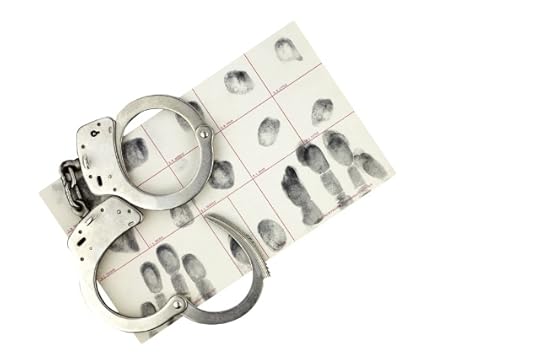
One colorful anecdote the detectives shared with me was that they would often take their suspects to a local bar and get them drunk to see if they would confess. A few detectives I spoke with said they even went as far as seventy miles north of Houston to Huntsville prison to pull suspects out, just to take them to the bar for interrogations! One of the detectives told me that one convict they took out of jail wasn’t a drinker, so they figured out that what he wanted more than anything was to see his wife and son. So they told him that if he confessed, he could see them. I found that to be just awful. And the detectives told me they did, too. They also had a lot of colorful names they called suspects: turds, scumbags, and actors. These details say a lot about how shady police work was during that time. Fortunately, there was a major push in the years that followed that shifted the focus to better training for police officers and increased ethical standards for all armed forces.
The most interesting thing I learned while I was doing my research was that there’s actually very little written (murder mystery or otherwise) about Houston society’s connection with the police work in the 1970s. So you’re in for quite a fun ride as you follow my detectives in Under a Cloud of Rain through the murder investigation to find the serial killer (or killers!).
June 15, 2016
Why Is Murder So Darn Fascinating?
As I’ve said before, I’ve known since I was a young girl that I wanted to write a murder mystery novel. (Probably not something most nine-year-old girls are thinking about!) As I got older, I began my career and started a family, but the desire never subsided: writing a murder novel remained a passion I wanted to pursue. And based on the publicity generated by serial killers I would argue that I’m not alone in my fascination with the subject! Some murderers—such as Ted Bundy and Charles Manson—even become idols.

My path to becoming a murder mystery writer (and avid reader of murder stories) has been unconventional to say the least. I started as an actress, then became a model, performed in off-Broadway plays, wrote screenplays, and even wrote, directed, and produced a short film that won an award. My career in filmmaking led me, in many ways, to writing serial killer novels, since my artistic film pieces intertwined destructive relationships and dramatic-thriller storylines. But it wasn’t until I had my children and became a stay-at-home mom that I started writing novels. I’ve come full circle from acting and producing to publishing my debut novel Under a Cloud of Rain, and my second in the Nick Noelle series, Thicker Than Blood.
I create and mold my characters—including the murderers—by playing with their thoughts, feelings, and motives for committing such heinous crimes. I live through my characters, and it’s a very intimate relationship. I believe that the stories of real-life murderers (and the television and movie criminals inspired by them) provide an outlet for society’s primal murderous impulses.
To be honest, our culture’s fascination with murder is pretty twisted. It almost teeters on the edge of being an addiction with all of today’s fictional television shows about murder (such as Law & Order) and primetime newsmagazine programs on the topic (like Dateline), and we definitely can’t avoid it in the daily news. When was the last time you turned on the local or national news and didn’t see a story about someone being killed? I can’t remember. So why are we so fascinated by murder?
Mention an infamous real-life killer, like Ted Bundy, in your social circle, and a conversation will likely ensue. Murder is a hot topic.
“Murder mania” is an obsession we as a culture have adopted—in real life and fiction. I have become obsessed with murder weapons since I began writing the wicked chain saw into Under a Cloud of Rain. I know my own fascination started when I was nine years old. When I was growing up in a well-to-do suburb of Houston, a wealthy local resident of my small community was the victim of a tragic and widely publicized murder. That murder has lived with me ever since, and it became the inspiration for the brutal murders in Under a Cloud of Rain.
I was raised among Houston’s upper crust, so I think what really struck me about that sensational story was how murder can happen anywhere, to anyone, in any socioeconomic class. Perhaps that’s the thread is that binds us in our fascination with murder: it can happen to any of us. And it’s something we all fear.
With increasingly sensationalized murder shows (How to Get Away with Murder, for example) and movies on offer, we continue to tune in. But if the bad guy doesn’t get slain at the end of the movie, will it be a blockbuster hit? Unlikely.
Reader roundup: What fascinates you about murder mystery novels?
June 8, 2016
The Ins and Outs of Ima Hogg Estate

My dear friend Kelly and I visiting the Ima Hogg estate.
While I was doing research for Under a Cloud of Rain, I had the pleasure of visiting the beautiful Ima Hogg estate in with a very dear friend of mine. Nestled in the historic River Oaks neighborhood of Houston, the house-turned-museum-turned-masterpiece is a philanthropist’s dream.
The story goes that Ima Hogg (1882-1975), daughter of the first native-born governor of Texas, was one of Houston’s most influential aristocrats. Named the “First Lady of Texas,” Miss Hogg was highly regarded by her peers and admired by philanthropists and civic leaders alike for her commitment to educational outreach. In addition to her charitable efforts, Miss Hogg had a lifelong passion for collecting art, furniture, and ceramics, which eventually led to the creation of the Bayou Bend Collection and Gardens of the Museum of Fine Arts, Houston. Today, the museum houses her incredible collection of decorative arts and paintings and is surrounded by fourteen acres of pristinely manicured gardens. The museum welcomes visitors to walk the halls and grounds of Miss Hogg’s picturesque vision year-round.

When the house was built in 1927, Miss Hogg and her two brothers worked closely with the architect to design it to reflect both eighteenth-century Georgian architecture and the Creole style of New Orleans homes. In 1957, Miss Hogg donated the house and her full collection of furnishings, paintings, and other art pieces, along with the grounds and gardens, to the Museum of Fine Arts, Houston (MFAH). After some remodeling, the Bayou Bend Collection and Gardens opened to the public in 1966. Miss Hogg continued adding to the museum’s extensive collection until she passed away in 1975.
Miss Hogg wanted her collection to tell the story of America’s history to the community of Texas, and we could feel the narrative emerge as we walked the grounds. According to the MFAH, the former Ima Hogg house “is one of the finest showcases of American furnishings, silver, ceramics, and paintings in the world.” MFAH comprises multiple facilities, including a sculpture garden, two gallery buildings, two art schools, and two house museums—one of which is the Ima Hogg house.
The most fascinating part of our visit to the estate was the ten-minute walk to the Ima Hogg house, located directly off the main museum complex grounds. To get to the house, we walked through beautiful gardens and dark woodlands and over a breathtaking bridge that looks out across Buffalo Bayou, the fifty-two-mile waterway that flows through Houston. I learned through talking with a tour guide that Miss Hogg wanted the garden walkways to feel like outdoor rooms—an extension of the living and entertaining areas. They truly did!
Touring the estate with its more than two thousand collectibles tucked into the twenty-eight-room mansion and sprawling grounds helped my creative juices. At the time, I was building out the scenes where the murders would take place in Under a Cloud of Rain, and as soon as I saw the mysterious woodlands—and their contrast with the luxurious house museum—I knew they would be the perfect setting for my characters’ darkest deeds.
June 1, 2016
The Real-Life Murder That Inspired Under a Cloud of Rain
During my childhood in River Oaks, Texas, a member of my community was gruesomely murdered. It was a case that gained nationwide attention. At the time of the event and during the sensational murder trial that ensued, I was very young, but it all spurred my love affair with writing and using my imagination to create stories and characters. I knew from that time on that I would one day write a mystery novel inspired by that crime.
The murder struck a chord with me, and it eventually became the inspiration for Under a Cloud of Rain. The brutal murders, the luxe social settings, and the characters from opposite sides of the social spectrum featured in Under a Cloud of Rain are all inspired by the grisly murder that shook my community and left a lasting imprint on me and my family. I was able to play with characters who I dropped into the Houston scene—the birthplace of these rich socialites and their lavish lifestyles with a murder twist that marries the two social classes.
When news of the murder of millionaire Jacques Mossler was first reported in the mid-1960s, the story was that an unknown assailant broke into Mossler and his wife Candace’s Florida vacation property and bludgeoned and stabbed him. That story was soon thrown out as the investigation began to suspect Candace Mossler and her nephew/lover of murdering her husband in his luxury apartment.
I didn’t include any incestuous love affairs in the novel, but there are plenty of steamy sex scenes between characters in Under a Cloud of Rain: Nick Noelle and Pamela, George Brunswick and Pamela, and Richard Lowden and Marianna, to name a few. I couldn’t resist! They were some of my favorites scenes to write.
Mossler and her nephew were never convicted. She remarried in 1971 and lived with her new husband in her River Oaks mansion until they divorced four years later, and she died the following year.
The Houston Chronicle a wonderful job explaining the details of the Mossler trial in a story about the case they ran fifteen years ago (you can read the full story here).
Although the murder took place eleven hundred miles away in the Florida Keys, the Mosslers’ primary home was just around the corner from where I grew up in the Houston suburb. The incestuous affair between Candace and her nephew took place in this home.
Dialogue and character development are two of my strengths as a writer, so creating the two types of characters—wealthy oil titans and middle-class hopefuls—was my favorite part about developing my first novel. I created my characters using my memory of the Mossler case because it was captivating. Those details helped me build my spiciest characters! I really enjoyed writing the big hitters in my book because they embodied a life of the over-the-top lifestyle like the Mosslers, but they also lived very vile lives.
Reader Roundup: What big news story from your childhood will you never forget?
May 25, 2016
17 Questions with A.R. Baumann
Rather than the normal blog post, I’m changing things up a bit! I wanted to write a more personal post to give you a chance to get to know me better, so below I’ve answered seventeen questions to give you a glimpse into my life as a writer, dreamer, and lover of life. I’d love to hear what you think, and feel free to send me any questions you have!
1. You were born and raised in Texas. Why do you love the Lone Star State?
I love Texas because it's my home. I come from a long line of Texans on my mother's side, which makes me a fifth-generation Texan. I was raised that my word is my bond. And I find a lot of people in Texas feel that way. I got my street smarts from my dad, who was born in Chicago.
2. What’s the one interesting fact you’d like readers to know about you?
I am a gypsy. I have lived in several cities including London, Milan, New York City, and Los Angeles, and I currently reside in San Francisco. I’ve also had several careers. I was a beauty model in London and Milan at eighteen. I was a stage actress in New York City for ten years. I was a maker of short films in Los Angeles. I didn’t even start writing novels until I was thirty-six years old.
3. What’s the question you get asked most by readers?
Readers are most interested in how I build my characters. I tell them I go about this by observing the many different people I meet on the road of life. I feel I can talk to anyone and learn something from all the people that come my way each day.
4. Why do you love writing?
I am the youngest in a big Texas family. When I was a child, my parents owned a bar, and all of us kids would hand out there before dinner. Everyone talked over me, so I love writing because it’s my chance to be heard.
5. How, when, and where do you enjoy writing?
I can write anywhere at any time. I have written waiting for a plane, on a plane, and in my office at home. This creative urge can, and does, strike at any time.
6. What are your favorite movies?
My favorites go way back to Citizen Kane, The Third Man, The Godfather and The Godfather Part II, The Razor’s Edge, and Hitchcock's Marnie.
7. What’s the most important lesson you learned while writing Under a Cloud of Rain: A Nick Noelle Mystery?
The most important lesson I learned was to trust myself during the process of building the bones of the book structure. I am great at dialogue, characters, and description, but I don’t always know the right order for where to place the scenes I write.
8. Any advice for new authors?
Follow your gut instincts. I believe in trusting in your instincts and letting the book go where it takes you. Trust the process without overanalyzing it all in your head.
9. What was the biggest challenge while writing Under a Cloud of Rain: A Nick Noelle Mystery?
I believe my biggest challenge was rewriting and rewriting many parts of the book and knowing when the editing was enough.
10. What was the biggest reward while writing Under a Cloud of Rain: A Nick Noelle Mystery?
The biggest reward was seeing the delight in some of my readers’ eyes when they told me that they couldn’t put my book down.
11. Where do you see yourself in ten years?
I see myself as a well-read author who has time to contemplate a great lifetime of work and love.
12. What’s your favorite mystery novel that you’ve read so far in 2016?
Dazzled by Maxine Nunes.
13. How do you develop characters?
I develop my characters by getting into the heads of all different kinds of people. I create the personalities of my characters using bits of everyone I meet—especially the characters who are the spiciest. When I start out with a character, I find I get more and more clarity on who they are as I write the scenes. These characters start to live with me. It can be a very intimate process.
14. Who is your favorite character in Under a Cloud of Rain: A Nick Noelle Mystery?
My favorite character is the detective Nick Noelle. Noelle is down-to-earth and imperfect to the point of being addicted to alcohol, babes, and gambling, but he has common sense, honor, and a big heart.
15. What was your dream job growing up?
You’re going to laugh, but really I wanted desperately to be a star!
16. What are some of the quotes from famous writers that inspired and motivated you while writing Under a Cloud of Rain: A Nick Noelle Mystery?
There weren’t any specific quotes that inspired me, but there were characters from films and books that inspired me to create my characters. Popeye, the detective from the film The French Connection, which was a big movie back in the 1970s, defined my Nick Noelle character. He was as gruff and at times as thick as Nick Noelle. My Mrs. George Brunswick character was taken from the great evil queen in the English movie The Queen of Spades. The other characters were created from many different people I have known or have been acquainted with through the years.
17. Coffee or tea? Coke or Pepsi?
All of the above as long as there is enough caffeine to get me on my way!
Do you have a question for me? Feel free to post them on my Facebook page !
Seventeen Questions with A.R. Baumann
Rather than the normal blog post, I’m changing things up a bit! I wanted to write a more personal post to give you a chance to get to know me better, so below I’ve answered seventeen questions to give you a glimpse into my life as a writer, dreamer, and lover of life. I’d love to hear what you think, and feel free to send me any questions you have!
1. You were born and raised in Texas. Why do you love the Lone Star State?
I love Texas because it's my home. I come from a long line of Texans on my mother's side, which makes me a fifth-generation Texan. I was raised that my word is my bond. And I find a lot of people in Texas feel that way. I got my street smarts from my dad, who was born in Chicago.

2. What’s the one interesting fact you’d like readers to know about you?
I am a gypsy. I have lived in several cities including London, Milan, New York City, and Los Angeles, and I currently reside in San Francisco. I’ve also had several careers. I was a beauty model in London and Milan at eighteen. I was a stage actress in New York City for ten years. I was a maker of short films in Los Angeles. I didn’t even start writing novels until I was thirty-six years old.
3. What’s the question you get asked most by readers?
Readers are most interested in how I build my characters. I tell them I go about this by observing the many different people I meet on the road of life. I feel I can talk to anyone and learn something from all the people that come my way each day.
4. Why do you love writing?
I am the youngest in a big Texas family. When I was a child, my parents owned a bar, and all of us kids would hand out there before dinner. Everyone talked over me, so I love writing because it’s my chance to be heard.
5. How, when, and where do you enjoy writing?
I can write anywhere at any time. I have written waiting for a plane, on a plane, and in my office at home. This creative urge can, and does, strike at any time.
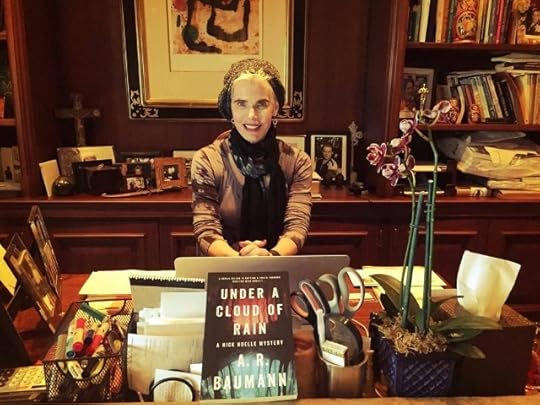
6. What are your favorite movies?
My favorites go way back to Citizen Kane, The Third Man, The Godfather and The Godfather Part II, The Razor’s Edge, and Hitchcock's Marnie.
7. What’s the most important lesson you learned while writing Under a Cloud of Rain?
The most important lesson I learned was to trust myself during the process of building the bones of the book structure. I am great at dialogue, characters, and description, but I don’t always know the right order for where to place the scenes I write.
8. Any advice for new authors?
Follow your gut instincts. I believe in trusting in your instincts and letting the book go where it takes you. Trust the process without overanalyzing it all in your head.
9. What was the biggest challenge while writing Under a Cloud of Rain?
I believe my biggest challenge was rewriting and rewriting many parts of the book and knowing when the editing was enough.
10. What was the biggest reward while writing Under a Cloud of Rain?
The biggest reward was seeing the delight in some of my readers’ eyes when they told me that they couldn’t put my book down.
11. Where do you see yourself in ten years?
I see myself as a well-read author who has time to contemplate a great lifetime of work and love.
12. What’s your favorite mystery novel that you’ve read so far in 2016?
Dazzled by Maxine Nunes.
13. How do you develop characters?
I develop my characters by getting into the heads of all different kinds of people. I create the personalities of my characters using bits of everyone I meet—especially the characters who are the spiciest. When I start out with a character, I find I get more and more clarity on who they are as I write the scenes. These characters start to live with me. It can be a very intimate process.
14. Who is your favorite character in Under a Cloud of Rain?
My favorite character is the detective Nick Noelle. Noelle is down-to-earth and imperfect to the point of being addicted to alcohol, babes, and gambling, but he has common sense, honor, and a big heart.
15. What was your dream job growing up?
You’re going to laugh, but really I wanted desperately to be a star!
16. What are some of the quotes from famous writers that inspired and motivated you while writing Under a Cloud of Rain?
There weren’t any specific quotes that inspired me, but there were characters from films and books that inspired me to create my characters. Popeye, the detective from the film The French Connection, which was a big movie back in the 1970s, defined my Nick Noelle character. He was as gruff and at times as thick as Nick Noelle. My Mrs. George Brunswick character was taken from the great evil queen in the English movie The Queen of Spades. The other characters were created from many different people I have known or have been acquainted with through the years.
17. Coffee or tea? Coke or Pepsi?
All of the above as long as there is enough caffeine to get me on my way!
Do you have a question for me? Feel free to post them on my Facebook page!
May 18, 2016
Four Reasons Growing Up in Texas High Society is a Ball
Everything is bigger in Texas, from the hair and heels to the boots and horses. And high society in Texas is bigger and better. My novel Under a Cloud of Rain: A Nick Noelle Mystery takes place in the 1970s, a time when aristocratic families ruled in Houston. Although I was raised in Texas (albeit not in the upper crust), my research left me with some interesting tidbits about the high society lifestyle then and now: read on to learn how growing up in Texas high society is a ball.
1. Debutante Balls and Bolo Ties
Traditionally, debutante balls served as a “coming out” to introduce young ladies from upper-class families to society, with the girls ranging in age from sixteen to twenty-one at the time of their formal “debut” presentation. Although Texans still hold the tradition near and dear to their hearts, the modern era has wiped away the antiquated function of debutante balls, and now they’re used more as an excuse to throw an extravagant party.
Texans like things big. So the formal attire—complete with bolo ties and dresses costing shocking amounts—speaks volumes about how significant of a place these events hold in the minds (and pocketbooks) of socialites.
Extravagant? Sure. But wouldn’t it be fun to throw on a $10,000 ball gown and dance the night away?
2. Extreme Etiquette
Just like the characters in my novel, I was raised to believe that good manners are paramount, and I find that a lot of people in Texas feel that way. The downside is that Texans can be polite almost to a fault. If you had been raised in Texas high society, you would never have to reference a handbook to climb the social ladder. When meeting someone new or going to a job interview, saying “Yes, ma’am,” and “Yes, sir,” is not a choice, it’s a respectful habit. Even if you don’t like someone, it’s ingrained in you to be polite—a trait many people can’t claim they have. Bless their hearts.
3. Money Talks
If you had grown up in Texas high society, you would have been rubbing elbows with the muckety-muck oil tycoons and big business philanthropists. But though Houston high society might be all about excess, fundraising and charity work are important reasons to roll out the red carpet and hit up other wealthy socialites for donations, and the money raised at these glitzy galas and charity luncheons is used to help those in need.
4. Big, Better, Best
Did I mention everything is bigger in Texas? It might be only the second-largest state in surface area, but just like the big hats and big egos, Texas infrastructure is bigger. The Texas capitol building is even taller than the United States Capitol building in Washington, D.C. If you had been raised in Texas high society, you could proudly shout your big history from the rooftops!
In Under a Cloud of Rain: A Nick Noelle Mystery I provide a glimpse into Houston high society, and give you a taste of what the adage “don’t mess with Texas” really means.
A.R. Baumann
Four Reasons Growing Up in Texas High Society is a Ball
Everything is bigger in Texas, from the hair and heels to the boots and horses. And high society in Texas is bigger and better. My novel Under a Cloud of Rain takes place in the 1970s, a time when aristocratic families ruled in Houston. Although I was raised in Texas (albeit not in the upper crust), my research left me with some interesting tidbits about the high society lifestyle then and now: read on to learn how growing up in Texas high society is a ball.
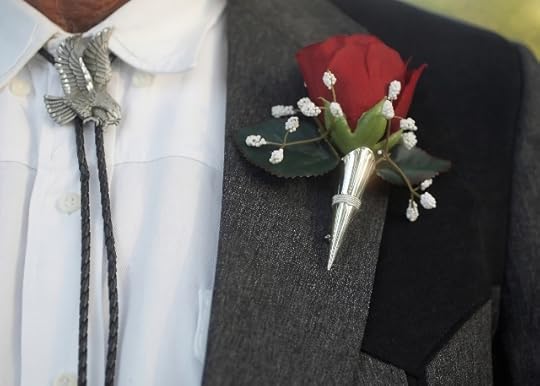
1. Debutante Balls and Bolo Ties
Traditionally, debutante balls served as a “coming out” to introduce young ladies from upper-class families to society, with the girls ranging in age from sixteen to twenty-one at the time of their formal “debut” presentation. Although Texans still hold the tradition near and dear to their hearts, the modern era has wiped away the antiquated function of debutante balls, and now they’re used more as an excuse to throw an extravagant party.
Texans like things big. So the formal attire—complete with bolo ties and dresses costing shocking amounts—speaks volumes about how significant of a place these events hold in the minds (and pocketbooks) of socialites.
Extravagant? Sure. But wouldn’t it be fun to throw on a $10,000 ball gown and dance the night away?
2. Extreme Etiquette
Just like the characters in my novel, I was raised to believe that good manners are paramount, and I find that a lot of people in Texas feel that way. The downside is that Texans can be polite almost to a fault. If you had been raised in Texas high society, you would never have to reference a handbook to climb the social ladder. When meeting someone new or going to a job interview, saying “Yes, ma’am,” and “Yes, sir,” is not a choice, it’s a respectful habit. Even if you don’t like someone, it’s ingrained in you to be polite—a trait many people can’t claim they have. Bless their hearts.

3. Money Talks
If you had grown up in Texas high society, you would have been rubbing elbows with the muckety-muck oil tycoons and big business philanthropists. But though Houston high society might be all about excess, fundraising and charity work are important reasons to roll out the red carpet and hit up other wealthy socialites for donations, and the money raised at these glitzy galas and charity luncheons is used to help those in need.
4. Big, Better, Best
Did I mention everything is bigger in Texas? It might be only the second-largest state in surface area, but just like the big hats and big egos, Texas infrastructure is bigger. The Texas capitol building is even taller than the United States Capitol building in Washington, D.C. If you had been raised in Texas high society, you could proudly shout your big history from the rooftops!
In Under a Cloud of Rain I provide a glimpse into Houston high society, and give you a taste of what the adage “don’t mess with Texas” really means.




